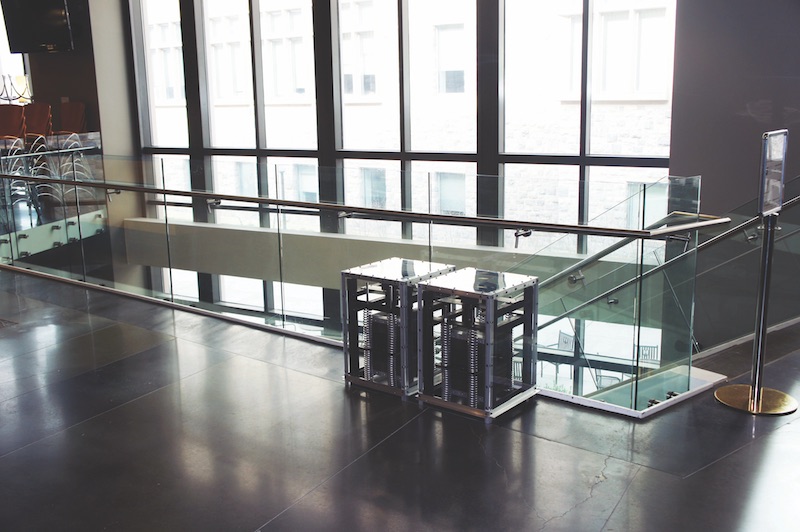The tuned mass damper used in Taiwan’s Taipei 101 tower represents an engineering feat that is so impressive the designers decided to make it publicly visible for all to see. Taipei 101’s 730-ton tuned mass damper may represent an extreme, but its purpose is the same as much smaller dampers that may be used in an office building or mall: to mitigate vibrations or sway that may otherwise alarm or cause discomfort to building occupants.
As building materials get lighter and designs push the limits of what is possible in architecture, structural vibrations are becoming more worrisome. A vibrating floor may not be dangerous, but it can certainly cause some unease among building occupants.
That’s where Mehdi Setareh, PhD, Professor, School of Architecture + Design at Virginia Tech’s College of Architecture and Urban Studies, comes in. With the help of a small team of students, he has created a portable tuned mass damper (PTMD) that weighs less than 275 pounds and is about the size of a shop vac. The device reduced vibrations by 40-75% in tests at Virginia Tech’s Vibration Testing Lab.
 Mehdi Setareh next to an early version of the Portable Tuned Mass Damper. Courtesy Virginia Tech.
Mehdi Setareh next to an early version of the Portable Tuned Mass Damper. Courtesy Virginia Tech.
The PTMD can be incorporated in new construction or added as a corrective measure in an existing building. Even nontechnical personnel can tune the device, using a $5 iTunes application and Setareh’s instructions. Because of the device’s small size, it can be easily hidden in a cabinet or even within furniture.
Plates, springs, and dampers that are built into the two-foot-tall, 15-inch-wide box are tuned to the natural frequency of a structure and reduce vibrations by moving in the opposite direction of that structure, but at 10 to 20 times higher acceleration rates.
Currently, the unit shows the most promise for use in structures with high foot traffic, such as theaters, malls, nightclubs, and monumental staircases, or in settings that have vibration-sensitive equipment, such as hospitals and labs.
Setareh has applied for a patent on the device. He plans to place it on the market as a kit of parts with instructions on how to assemble, install, and tune the damper.
Related Stories
Design Innovation Report | Apr 27, 2023
BD+C's 2023 Design Innovation Report
Building Design+Construction’s Design Innovation Report presents projects, spaces, and initiatives—and the AEC professionals behind them—that push the boundaries of building design. This year, we feature four novel projects and one building science innovation.
Design Innovation Report | Apr 19, 2023
Reinforced concrete walls and fins stiffen and shade the National Bank of Kuwait skyscraper
When the National Bank of Kuwait first conceived its new headquarters more than a decade ago, it wanted to make a statement about passive design with a soaring tower that could withstand the extreme heat of Kuwait City, the country’s desert capital.
Design Innovation Report | Apr 19, 2023
HDR uses artificial intelligence tools to help design a vital health clinic in India
Architects from HDR worked pro bono with iKure, a technology-centric healthcare provider, to build a healthcare clinic in rural India.
3D Printing | Apr 11, 2023
University of Michigan’s DART Laboratory unveils Shell Wall—a concrete wall that’s lightweight and freeform 3D printed
The University of Michigan’s DART Laboratory has unveiled a new product called Shell Wall—which the organization describes as the first lightweight, freeform 3D printed and structurally reinforced concrete wall. The innovative product leverages DART Laboratory’s research and development on the use of 3D-printing technology to build structures that require less concrete.
Cladding and Facade Systems | Apr 5, 2023
Façade innovation: University of Stuttgart tests a ‘saturated building skin’ for lessening heat islands
HydroSKIN is a façade made with textiles that stores rainwater and uses it later to cool hot building exteriors. The façade innovation consists of an external, multilayered 3D textile that acts as a water collector and evaporator.
Transportation & Parking Facilities | Mar 23, 2023
Amsterdam debuts underwater bicycle parking facility that can accommodate over 4,000 bikes
In February, Amsterdam saw the opening of a new underwater bicycle parking facility. Located in the heart of the city—next to Amsterdam Central Station and under the river IJ (Amsterdam’s waterfront)—the facility, dubbed IJboulevard, has parking spots for over 4,000 bicycles, freeing up space on the street.
Concrete | Jan 24, 2023
Researchers investigate ancient Roman concrete to make durable, lower carbon mortar
Researchers have turned to an ancient Roman concrete recipe to develop more durable concrete that lasts for centuries and can potentially reduce the carbon impact of the built environment.
Sponsored | Resiliency | Dec 14, 2022
Flood protection: What building owners need to know to protect their properties
This course from Walter P Moore examines numerous flood protection approaches and building owner needs before delving into the flood protection process. Determining the flood resilience of a property can provide a good understanding of risk associated costs.
Giants 400 | Nov 14, 2022
4 emerging trends from BD+C's 2022 Giants 400 Report
Regenerative design, cognitive health, and jobsite robotics highlight the top trends from the 519 design and construction firms that participated in BD+C's 2022 Giants 400 Report.
AEC Tech | Apr 13, 2022
A robot automates elevator installation
Schindler—which manufactures and installs elevators, escalators, and moving walkways—has created a robot called R.I.S.E. (robotic installation system for elevators) to help install lifts in high-rise buildings.















